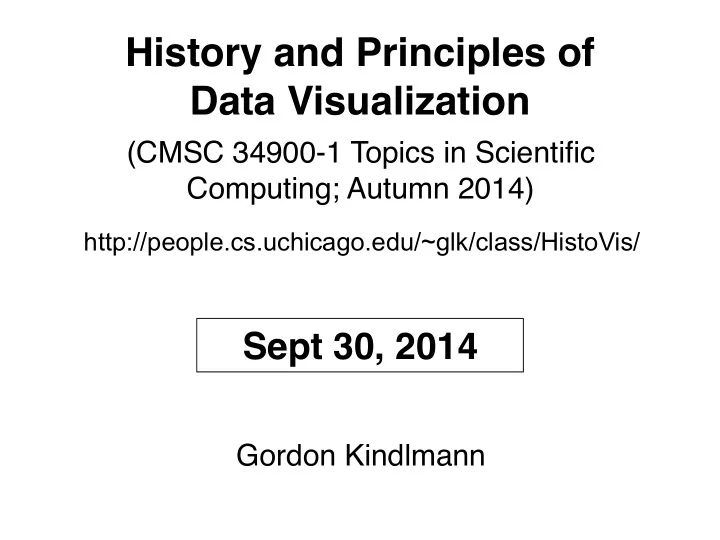

History and Principles of Data Visualization (CMSC 34900-1 Topics in Scientific Computing; Autumn 2014) http://people.cs.uchicago.edu/~glk/class/HistoVis/ Sept 30, 2014 Gordon Kindlmann
How to learn about a set of numbers? Summary statistics • Sets I, II, III, IV of (x i ,y i ) have identical: • • mean, variance {x i } • • mean, variance {y i } • • line of best fit (least-squares sense)
Anscombe’s quartet http://en.wikipedia.org/wiki/Anscombe's_quartet
Anscombe’s message • [Anscombe-GraphsInStatAn-1973] • “A computer should make both calculations and graphs. Both sorts of output should be studied; each will contribute to understanding” • “Thought and ingenuity devoted to devising good graphs are likely to pay off” • “In practice,we do not know that the theoretical description is correct, we should generally suspect that it is not, and we cannot therefore heave a sigh of relief when the regression calculation has been made, knowing that statistical justice has been done.” • (i.e. If you’re doing computations on data, you need to see what you’re doing!)
2012 Presidential Election REPUBLICAN DEMOCRAT http://www.npr.org/blogs/itsallpolitics/2012/11/01/163632378/a-campaign-map-morphed-by-money
2012 Presidential Election http://gizmodo.com/5960290/this-is-the-real-political-map-of-america-hint-we-are-not-that-divided
2012 Presidential Election http://www.npr.org/blogs/itsallpolitics/2012/11/01/163632378/a-campaign-map-morphed-by-money
2012 Presidential Election http://www.npr.org/blogs/itsallpolitics/2012/11/01/163632378/a-campaign-map-morphed-by-money
2012 Presidential Election http://www.npr.org/blogs/itsallpolitics/2012/11/01/163632378/a-campaign-map-morphed-by-money
Clarifying distortions Tube map from 1908 http://www.20thcenturylondon.org.uk/beck-henry-harry http://briankerr.wordpress.com/2009/06/08/connections/ http://en.wikipedia.org/wiki/Harry_Beck
Clarifying distortions http://www.20thcenturylondon.org.uk/beck-henry-harry Harry Beck 1933 http://briankerr.wordpress.com/2009/06/08/connections/ http://en.wikipedia.org/wiki/Harry_Beck
Clarifying distortions
Clarifying distortions Joachim Böttger, Ulrik Brandes, Oliver Deussen, Hendrik Ziezold, “ Map Warping for the Annotation of Metro Maps ” IEEE Computer Graphics and Applications, 28(5):56-65, 2008
Maps reflect conventions, choices, and priorities “A single map is but one of an indefinitely large number of maps that might be produced for the same situation or from the same data.” Mark Monmonier “How to Lie with Maps”, 1991
Showing population flux moving out moving in Note use of (roughly) opponent hues in colormap, centered around gray (neutral) to indicate zero http://www.datapointed.net/2011/04/maps-us-population-change-2000-2010-census/
Different tasks for colormaps
Value of showing isocontours Quality/Utility of colormap hinges on perceptual psychology
Affordances http://www.kkstudio.gr/#the-uncomfortable “uncomfortable” object design by Katarina Kamprani Our experiences of the affordances in design is also part of psychology
Three main bodies of knowledge • Cartography / Geography • Statistics • Psychology
Fields of Visualization Computer Science Statistics, Calculus, Computer Graphics Numerical Machine Learning Methods Human-computer interaction Perceptual Psychology Information Scientific Visualization Visualization Data Visualization Info- Scientific graphics Illustration
This class: • Goal: understand the underlying principles at play in data visualization (practice & research), and their history • How: • 1) Read, present, discuss the commonly cited literature and its context • 2) Do a project implementing a vis method • Why this class? •
What is being visualized? • Data = set of values (or datum) X • Spreadsheet: {X i } i=1..N ; X i =(a i ,b i ,c i ,...) coordinates may be spatial or geographical • Function of time: X = F(t) • Function over 2D X = F(u,v) i.e. an image, or volume F(u,v,w), or 3D surface F(s,t) • Graph: X = (Vert,Edge) or (Vert,Arrow) • Each X is a label or number (or vector of them) • Each different type (or flavor) of number has its own mathematical structure: “scales of measurement”
Scales of measurement
Stevens’ 4 scales of measurements http://en.wikipedia.org/wiki/Level_of_measurement Nominal Categorical Qualitative Ordinal Interval Ratio • Later scales specialize earlier scales • Some examples of these ...
The structure of data values Understanding qua li- tative Categorical • the nature of discrete the data helps choose sensible Ordinal ways to show it • qua nt itative continuous Interval • Scalars Ratio Vectors 0 • Tensors
Value of showing isocontours
Fields of Visualization related to data {X i } i=1..N ; X i =(a i ,b i ,c i ,...) Information X = F(t) Visualization X = (Vert,Edge) X = F(u,v) X = F(u,v,w) Scientific X = F(s,t) (3D surface) Visualization X : vectors, tensors
Recommend
More recommend